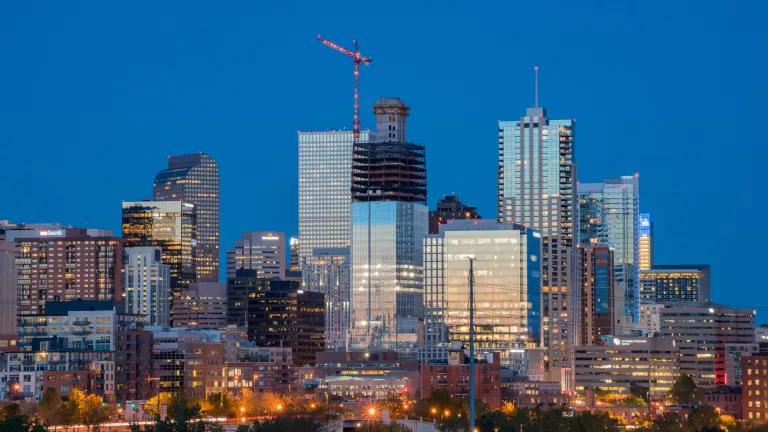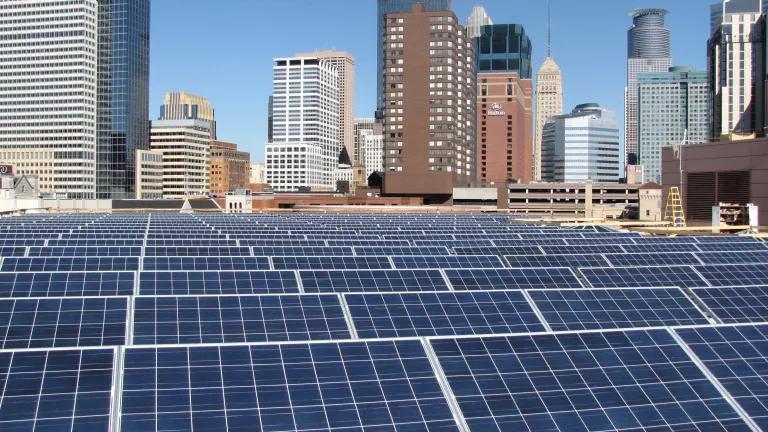New Stretch Code Will Mean Low-Carbon Buildings
The 2021 International Energy Conservation Code (IECC) improves the energy efficiency of new buildings but does not go so far to directly address their climate emissions.

Transitioning America’s buildings away from burning fossil fuels for heating and water heating, toward equipment powered by increasingly clean electricity is key to meeting the nation’s climate goals, including President Biden’s commitment to net-zero carbon emissions by 2050. Innovative energy code language, developed by the New Buildings Institute in partnership with NRDC and released recently, will provide a template to help get cities and states on track to reduce energy use as well as carbon emissions in new buildings.
Buildings are responsible for around 40 percent of all carbon emissions in the United States, so addressing their efficiency and emissions is critical to meet our climate goals. The recently-released 2021 International Energy Conservation Code (IECC) includes significant gains to improve the energy efficiency of new buildings, like requiring additional insulation, but does not go so far to directly address the climate emissions of buildings.
The Building Decarbonization Code developed by NBI with support from NRDC, is an overlay, or “stretch” code, designed to be compatible with the 2021 IECC—but go even further. It covers both residential and commercial new construction and is intended to help reduce the amount of carbon being emitted inside and from buildings.
Energy codes are adopted at the state or local level, so the Decarbonization Code is an optional pathway for communities wanting to lead the way on cleaner, healthier buildings. It’s designed to meet jurisdictions where they are in their fight against the climate crisis, by promoting–but not requiring–low-carbon electrification of building end uses.
The Decarbonization Code template has two pathways to reduce climate-warming carbon emissions:
- One to follow if a building is constructed using “mixed fuels” (including natural gas or other fossil fuels like propane or oil), and
- One if a building is fueled only with electricity.
The “mixed fuel” pathway requires additional energy efficiency upgrades beyond what is required in the 2021 IECC and also requires a building to be constructed to be “electric-ready,” meaning it has the necessary wiring and electrical capacity to support converting from fossil fuels to electric equipment in the future.
The “electric-only” pathway requires only the “base” amount of energy efficiency specified in the 2021 IECC, but also includes additional language to promote renewable energy use, electric vehicle readiness, and grid connectivity. All requirements are customized to be appropriate for different climate zones.
Why electrify?
Buildings generate greenhouse gas emissions in two ways: either by consuming electricity generated at power plants with fossil fuels, or by directly burning fossil fuels on-site to run appliances like furnaces and water heaters. The Decarbonization Code addresses the direct, on-site fossil fuel consumption of buildings, while readying buildings for the shift toward a cleaner electric grid.
Electrifying buildings means lower carbon emissions from them over time, as we elaborate on in a new fact sheet. The electricity grid is increasingly powered by clean, renewable energy like wind and solar, a trend that is projected to continue. As the electricity being transmitted over the grid emits less carbon, every electrified home or building connected to that grid also becomes “cleaner”—and that means big savings. Switching to efficient electric heating systems and appliances powered by pollution-free electricity could cut U.S. carbon emissions by a whopping 1 billion tons annually. In contrast, the carbon emissions of gas or fossil-fuel powered equipment will remain consistent over the life of the equipment, locking in those emissions that can harm our health and the environment.
Furthermore, all-electric buildings have the potential to be significantly more efficient than buildings constructed to use fossil fuels. For example, today’s advanced electric heat pump technology is readily available, while being three to five times more efficient than typical gas and electric resistance equipment for heating water and indoor spaces.
Why a decarbonization code?
Individual jurisdictions make their own decisions about which energy codes to adopt. The landscape is currently fragmented, with some states following codes that date to 2009 or earlier even though there have been significant advances in energy efficiency technologies, such as better windows and advanced insulation. But many places are looking to lead the way in cutting carbon emissions, especially cities—and up until the release of the Decarbonization Code, places that want to lead the way have had to figure out how to do so on their own, by developing their own requirements. A decarbonization-focused energy code is an important tool that smooths the way for the hundreds of jurisdictions that have aggressive climate-related goals, including more than 200 cities that have pledged to achieve 100 percent clean electricity or “net-zero” emissions.
It is cheapest and easiest to electrify buildings—or make them ready for future electrification–at the time of construction. Constructing new buildings that support electrification from the start and are consistent with these goals is the best way to stop “digging the hole” of carbon emissions—and create a cleaner, more sustainable future for all.


